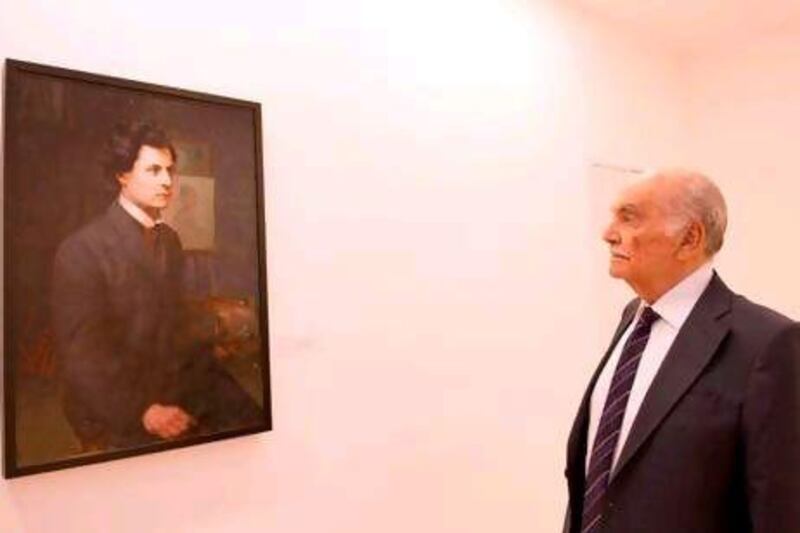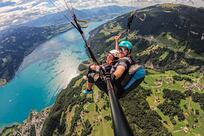In the summer of 1928, the Lebanese painter Khalil Saleeby and his wife Carrie Aude were murdered outside their home at the foot of Mount Lebanon.
Saleeby had a steady run of commissions at the time, several of which sat unfinished in his studio. The artist was toying with techniques he'd learnt in Europe, employing new-found pinks and opalescent blues. He was also painting nudes. Time with impressionists like Pierre-Auguste Renoir and Gustave Corbet in Paris had brightened his palette and softened the academicism and objective rigour of his earlier work.
"I've read notes from the trial after the murder, and the prosecutor is trying to portray Saleeby as some sort of pervert," says Octavian Esanu, a curator brought in to put together the first public exhibition of Saleeby's work that opened last week at the American University of Beirut (AUB). "But the judge countered this; he said he was a genius, a hero, someone who introduced fresh ideas into this country."
In November last year, Dr Samir Saleeby - a distant relative of the artist - gifted 59 paintings and four watercolours to AUB, including 31 by Khalil himself.
"Extraordinary people have a crazy or childish side to them," says Dr Saleeby, now in his 80s, referring to the painter's dispute with local farmers over the use of a freshwater spring that somehow escalated into his murder.
"My father tried to tell Khalil to not be so stubborn and let the farmers use the water that was on his land. Of the thugs who killed him, one of them was hanged, three spent some 30 years in prison. We lost Khalil."
Dr Saleeby, who has turned down several handsome offers for Khalil's works over the years, has now gifted his collection to AUB, albeit with certain strings attached: the paintings must never be sold, they must be the subject of academic research and be made available for the public to see. The current exhibition continues until November and has been designed to tie the chronology of the painter's life to certain thematic concerns and show how a traditional portrait painter blazed a very modernist trail in regional art.
AUB also plans to build the Rose and Shaheen Saleeby Museum, in honour of the doctor's parents, which will be partially funded by private donors. When it opens in 2020, it will provide a permanent home for these excellently preserved examples of Lebanese modernist art and a space to exhibit potential future donations.
Born in 1870, Saleeby studied at the Syrian Protestant College (what is today AUB) before heading to the West to pursue his ambitions.
In 1890, he eschewed the artistic centres of Paris and Rome and moved instead to drizzly Edinburgh, where he met John Singer Sargent, an American portraitist. The two became close friends and Sargent encouraged the younger painter, sharing his self-conscious technique of dense layered brushstrokes. He also pushed Saleeby to visit America where, in Philadelphia, he met his future wife.
"We want to emphasise his relationship with Carrie Aude in the exhibition, because he made a lot of portraits of her and in them one can see a very tender relationship," says Esanu.
The couple moved to Paris shortly afterwards. There, Saleeby met Pierre Cecile Puvis de Chavannes and Renoir, and exhibited at the impressionist-focused gallery owned by Paul Durand-Ruel.
Too often, the Lebanese painter is stylistically linked to the impressionists. Henri Franses, associate professor in the department of fine art and art history at AUB, refutes that: "He's much more solid ... the impressionists are concerned with the play of light on surfaces, whereas Saleeby is after getting hold of the object itself."
But the experience did have a considerable effect on the painter's work. By the time he and Aude returned to Lebanon in 1900 there's a sense of levity in the paintings that isn't there before - his images brighten, his backgrounds are more accomplished and angular.
Simultaneously, their return to Mount Lebanon initiated a period of intense creativity, which the AUB exhibition captures. It shows off the rural lifestyle he began to focus on, painting several portraits of farmers in the fez-like tarboush hat.
"He's got some idea of the folkloric aspect of Lebanon, but doesn't romanticise," says Franses. A decade in the West had made Saleeby curious about his own land, but no stranger to it. "These aren't Orientalised portraits in the manner of the itinerant European painters who travelled through the Middle East. There's a deep sympathy and familiarity. He's not painting these people as the Other."
By the time Saleeby died, he was also painting nudes. They are enigmatic images, not just for their transgression of a taboo in visual art that still largely remains across the region, but because of strange details. In an image of his wife, for instance, she turns with her back to the painter and steadies herself against the wall with a hand adorned in a pink glove. A male nude from 1913 stands in an odd and unnatural pose. Many of the paintings hint at being studies for a much grander work.
"Painting nudes might have been standard fare in Europe, but in Lebanon it was not," says Franses.
Saleeby would have been unable to exhibit these works publicly until the end of Ottoman control over Lebanon, according to Esanu. Even under the French administration that followed, social mores would likely have kept these out of the public domain.
He was a traditionalist painter in a manner that was outmoded in the West as cubism raged out of ateliers across Europe. But his way of working and thinking, it could be argued, grasped onto the globalism that would define modern and contemporary art - he was one of the first generation of Middle Eastern painters to have travelled and returned with an understanding of the western mode of oil painting. Perhaps most significantly, his subject matter would set him at odds with the grain even today in a country with great variations in its notions of decency.
Was there ever any concern at AUB about these nudes going so public? "There's every opinion in Beirut," says Richard Brow, vice-president of the university. "Some are comfortable with nudes being depicted in art, others are not. But the work is artistic, very tasteful and not in any way offensive."
Four of these paintings are currently on loan to L'Institut du Monde Arabe for its exhibition on the history of the naked body in art from the Middle East, in which Saleeby emerges as a daring precursor.
He schooled a subsequent generation of artists in Lebanon - Cesar Gemayal, Omar Onsi and Salibha Douaihy (all of whom have works in the collection gifted to AUB). Yet his pupils are better documented. According to Dr Saleeby, they took some of the credit for the innovations that the senior artist had pioneered. "Also, when he was assassinated, the court [case] went on for years. Everyone forgot about his paintings and instead talked about him and his wife and their murder."
The planned Rose and Shaheen Saleeby Museum, and the flurry of interest in Khalil, may go some way to addressing this.
Over 30 works by Khalil Saleeby are on show at the newly inaugurated AUB Art Gallery on Sidani Street, Beirut, until November.





